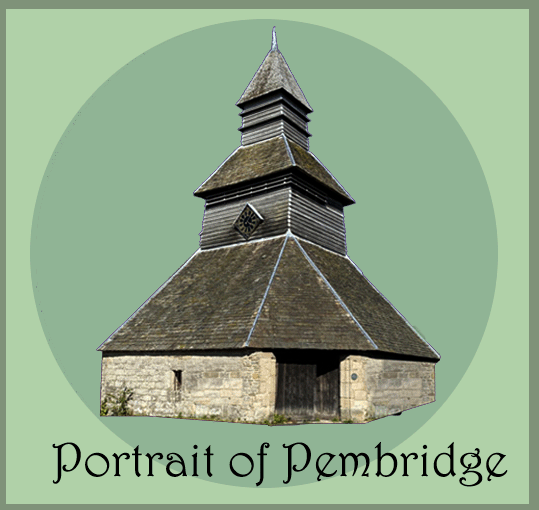The Bell Tower
At the Court of Buckingham Palace
18th DAY OF MAY 1982
PRESENT
THE QUEEN’S MOST EXCELLENT MAJESTY IN COUNCIL
This headed the agreement to make the Bell Tower at St Mary’s Church, Pembridge redundant! Notice of this order was published in the London Gazette on 21st May 1982.
On 1st September 1982, the bell tower was conveyed to the care of the Pembridge Parish Council. There were certain conditions: it had to be kept in good repair, access retained, and it was not to be used for illegal or immoral purposes! The Conveyance was signed by Parish Councilors Frank Lawrence Smith (The Leen) and Edward Ralph Neville Parker and witnessed by M. Reid.
The Bell Tower at Pembridge is considered the finest of the seven detached towers in the county of Herefordshire. Structurally it is related to the stave churches of Norway and the bell houses of Sweden. Eight immense oak pillars form a square. When it was restored in 1898 and 1957 extra timbers were inserted and strengthened with concrete (not a material that is now recommended for use in timber buildings). In 1983 -1984 The Department for the Environment funded a complete restoration. During this process, it was discovered that some of the timbers could be dated to 1207 – 1214 and that some walls and trusses were inserted in the 15th, 16th, and 17th centuries.
In 1996 – 1998 Historic England commissioned Sheffield University Dendrochronology Laboratory and after sampling suitable timbers, they considered that the present structure was a product of a single phase of construction dated to 1668/69. It incorporated re-used timbers of the early 13th century and re-used 16th-century timbers in the upper spire.
There are five bells. The 10½ cwt bell dates from 1658 but the others are more recent with one being re-cast in 1737 and two re-cast in 1898 (presumably part of the restoration work mentioned above). Churchwardens seemed to have been favoured with inscriptions on the treble and fourth and the Rector AP Turner and another churchwarden inscribed on the tenor bell. Gill Smith and Jackie Thomas next?
For Whom the Bell Tolls
Bell ringing can be a hazardous business. Although I cannot find any record of a problem in St Mary’s, St Lawrence’s in Presteigne had a fatality in 1892.
“We regret to state that Mr George Vaughan, aged 37, stone mason, and one of the ringers at the parish church, lost his life under unusual circumstances. The church bells had been left, after ringing for evening service on the previous day, in a position known as “set” and Mr Vaughan went to the belfry about two o’clock in the afternoon to correct some fault with the gear. He was not afterwards seen, but when some of the ringers went to the belfry in the evening they found Mr. Vaughan dead. His body was astride a beam amongst the bells. It is supposed that in the course of his work he dislodged one of the bells, causing it to swing over, and that, to save himself, he had clutched the wheel of another, and caused that to fall also. One of them had evidently struck him on the head killing him instantly. Several people recall noticing the sudden striking of one or two of the bells about three o’clock. The coroner summed up and the jury returned a verdict of accidental death. They expressed the opinion that the practice of leaving the bells at set was a dangerous one, and ought to be discontinued. George Vaughan, his widow, and infant son are buried in St Lawrence churchyard, Presteigne.
More recently (2017), Ian Bowman had to be lowered 80 feet (24 meters) when he was injured after being flipped upside down and dropped in a freak bell-ringing accident in Worcester Cathedral. He was rescued by a specialist rescue unit. Mr. Bowman said, "The rope went round my ankle, and it took me from standing to upside down in seconds." B.B.C. News
It is amazing what you can find on the internet. Put ‘St Mary’s Bell Tower, Pembridge’ in a search engine and you will find a host of differing theories, but the one thing on which they all agree is that it is a remarkable building. We are very lucky.
Judith Rogers
Photographs: - Dean Morris


